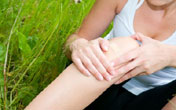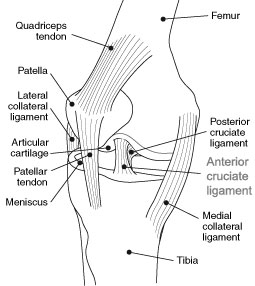Importance
 Anterior
cruciate ligament (ACL) injuries are amongst the most common season
or career ending knee injuries for athletes. Unfortunately, ACL
injuries can impact the athlete both emotionally and psychologically
in addition to the obvious physical limitations they place on
training and performance. However, the economic implications of ACL
injuries in the United States are as staggering as they are
overlooked. ACL patients requiring surgery account for 1.5 billion
dollars annually in health care costs (1). Physical therapists and
coaches must be attentive in their design of practices and strength
training routines to include exercises that can help to prevent ACL
injuries if only to keep their athletes healthy and happy. However,
it is imperative that preventative measures are taken with female
athletes for reasons beyond keeping them healthy and happy. Female
athletes are four to six times more likely to injure the ACL than
males (1, 2). As a result, females account for a huge portion of the
1.5 billion dollars in health care costs associated with ACL
injuries mentioned earlier. The best treatment for an ACL injury is
prevention. Studies have shown that prevention programs focused on
neuromuscular training and proprioceptive training decreases the
risk for an athlete 3.6-3.7 times than the control groups (1, 3).
Physical therapists play a large role in the development of these
programs and the ability to rehabilitate athletes from any type of
knee injury while decreasing the risk of ACL injuries.
Anterior
cruciate ligament (ACL) injuries are amongst the most common season
or career ending knee injuries for athletes. Unfortunately, ACL
injuries can impact the athlete both emotionally and psychologically
in addition to the obvious physical limitations they place on
training and performance. However, the economic implications of ACL
injuries in the United States are as staggering as they are
overlooked. ACL patients requiring surgery account for 1.5 billion
dollars annually in health care costs (1). Physical therapists and
coaches must be attentive in their design of practices and strength
training routines to include exercises that can help to prevent ACL
injuries if only to keep their athletes healthy and happy. However,
it is imperative that preventative measures are taken with female
athletes for reasons beyond keeping them healthy and happy. Female
athletes are four to six times more likely to injure the ACL than
males (1, 2). As a result, females account for a huge portion of the
1.5 billion dollars in health care costs associated with ACL
injuries mentioned earlier. The best treatment for an ACL injury is
prevention. Studies have shown that prevention programs focused on
neuromuscular training and proprioceptive training decreases the
risk for an athlete 3.6-3.7 times than the control groups (1, 3).
Physical therapists play a large role in the development of these
programs and the ability to rehabilitate athletes from any type of
knee injury while decreasing the risk of ACL injuries.
Anatomy
 The anatomy of the ACL and the surrounding structures is an
important factor to consider when developing programs to prevent ACL
injuries in athletes. Female athletes have a greater Q angle than
males, which increases the amount of valgus forces at the knee
creating an unstable mechanism (1, 4). The main function of the ACL
is to decelerate the lower extremity with movement as the tibia
internally rotates and the hip internally rotates (4). This is
extremely important in the athletic setting because any weakness
during eccentric loading of the lower extremity forces increased
strain on the ACL by increasing the load on the ACL (4). Individuals
with a high risk of ACL injuries are typically in a position where
the pelvis and hip are uncontrolled. This lack of control over the
pelvis and hip put the hip abductors and extensors at a disadvantage
and eventually force these muscles to shut down (3).
The anatomy of the ACL and the surrounding structures is an
important factor to consider when developing programs to prevent ACL
injuries in athletes. Female athletes have a greater Q angle than
males, which increases the amount of valgus forces at the knee
creating an unstable mechanism (1, 4). The main function of the ACL
is to decelerate the lower extremity with movement as the tibia
internally rotates and the hip internally rotates (4). This is
extremely important in the athletic setting because any weakness
during eccentric loading of the lower extremity forces increased
strain on the ACL by increasing the load on the ACL (4). Individuals
with a high risk of ACL injuries are typically in a position where
the pelvis and hip are uncontrolled. This lack of control over the
pelvis and hip put the hip abductors and extensors at a disadvantage
and eventually force these muscles to shut down (3).
Seventy percent of all ACL injuries are noncontact (4) and the
mechanism of injury is as follows: relatively little flexion, with
hip internal rotation and adduction on a pronated and externally
rotated foot (4). As you can see, many ACL injuries involve not only
the biomechanics of the knee but those of the hip and ankle as well.
Neuromuscular programs have been developed to improve the stability
of the lower extremity with functional close chain exercises at the
hip, knee, and ankle.
Prevention
Evidence supports the need for neuromuscular and proprioceptive
retraining for the prevention of ACL injuries. Stability training
helps to improve the athlete’s ability to co-contract the lower
extremity. Additionally, stability training has proven instrumental
in providing proprioceptive feedback with unpredictable dynamic
activity (2). A study by Paterno et al concluded that a six week
neuromuscular training program being utilized three days per week
improved total anterior/posterior postural stability in young female
athletes (4).
A comprehensive neuromuscular program was described in the article
by Paterno. The focus of the preventative program for female
athletes included three subgroups. The first subgroup included
female athletes engaging in balance training and hip, pelvis, and
trunk strengthening. The second subgroup included female athletes
engaging in plyometrics and dynamic movement training. The final
subgroup included female athletes engaging in resistance training.
This study shows that participation in all three groups over a six
week period; postural and stability changes occurred. With this
evidence, it is important for all therapists and coaches to
education themselves on proper form and corrections for athletes to
minimize their risk of injury. The importance of ACL prevention
programs is to educate the athlete on safe positions, proper
posture, and the ability for the athlete to self-correct.
Proprioceptive retraining is important with all dynamic
sport-related maneuvers. Cutting, jumping, and quick start and stop
motions are of particular importance during proprioceptive
retraining. Prevention programs focus on completing these activities
with proper biomechanics. All close chain functional activities
should be performed using methods to minimize the amount of stress
placed on the body. An example would be proper jumping mechanics.
Each athlete must land on the balls of their feet before
transferring their weight to their heels. Athletes should also be
required to land with bent knees and their center of gravity shifted
forward (1). Additional cues with which to provide the athlete
include having a soft landing with toe to heel rocking in order to
decrease the ground reaction forces (1). Many athletes, specifically
females, tend to perform plyometric activities in a more upright
position. This creates greater force on the knee and maximizes the
anterior shear forces of the quad. Ultimately, these greater forces
combine to increase the total load on the knee which can lead to ACL
injury (1). Proper verbal cuing is important to maximize the benefit
of the neuromuscular retraining and begin to teach the athlete how
to self-correct.
In conclusion, the evidence mentioned above supports the need for
proper training and education for therapists, athletes, and coaches
to minimize the risk of season ending knee injuries. Without the
proper stability training, postural cuing, and education, athletes
will continue to fall into poor biomechanics and increase the load
and stress on the ACL. With the proper education, many noncontact
ACL injuries can be prevented allowing athletes to have successful
and accomplished seasons.
Last revised: November 14, 2010
by Elisa Suchy, DPT
References:
1) Boden, BP, Griffin LY, et al.
Etiology and Prevention of Noncontact ACL Injury. The Physician and Sports
Medicine. 2000;28.
2) Paterno, M et al. Neuromuscular Training Improves Single-Limb Stability
in Young Female Athletes. Journal of Orthopaedic and Sports Physical
Therapy. 2004;34:305-316.
3) Ireland, M. Anterior Cruciate Ligament Injury in Female Athetes:
Epidemiology. Journal of Athletic Training 1999;34:150-154.
4) Griffin LY, Agel J, Albohm MJ, et al. Noncontact anterior cruciate
ligament injuries: risk factors and prevention strategies. JournalA of the
American Academy of Orthopaedic Surgeons. 2000;8:141-150.



 Anterior
cruciate ligament (ACL) injuries are amongst the most common season
or career ending knee injuries for athletes. Unfortunately, ACL
injuries can impact the athlete both emotionally and psychologically
in addition to the obvious physical limitations they place on
training and performance. However, the economic implications of ACL
injuries in the United States are as staggering as they are
overlooked. ACL patients requiring surgery account for 1.5 billion
dollars annually in health care costs (1). Physical therapists and
coaches must be attentive in their design of practices and strength
training routines to include exercises that can help to prevent ACL
injuries if only to keep their athletes healthy and happy. However,
it is imperative that preventative measures are taken with female
athletes for reasons beyond keeping them healthy and happy. Female
athletes are four to six times more likely to injure the ACL than
males (1, 2). As a result, females account for a huge portion of the
1.5 billion dollars in health care costs associated with ACL
injuries mentioned earlier. The best treatment for an ACL injury is
prevention. Studies have shown that prevention programs focused on
neuromuscular training and proprioceptive training decreases the
risk for an athlete 3.6-3.7 times than the control groups (1, 3).
Physical therapists play a large role in the development of these
programs and the ability to rehabilitate athletes from any type of
knee injury while decreasing the risk of ACL injuries.
Anterior
cruciate ligament (ACL) injuries are amongst the most common season
or career ending knee injuries for athletes. Unfortunately, ACL
injuries can impact the athlete both emotionally and psychologically
in addition to the obvious physical limitations they place on
training and performance. However, the economic implications of ACL
injuries in the United States are as staggering as they are
overlooked. ACL patients requiring surgery account for 1.5 billion
dollars annually in health care costs (1). Physical therapists and
coaches must be attentive in their design of practices and strength
training routines to include exercises that can help to prevent ACL
injuries if only to keep their athletes healthy and happy. However,
it is imperative that preventative measures are taken with female
athletes for reasons beyond keeping them healthy and happy. Female
athletes are four to six times more likely to injure the ACL than
males (1, 2). As a result, females account for a huge portion of the
1.5 billion dollars in health care costs associated with ACL
injuries mentioned earlier. The best treatment for an ACL injury is
prevention. Studies have shown that prevention programs focused on
neuromuscular training and proprioceptive training decreases the
risk for an athlete 3.6-3.7 times than the control groups (1, 3).
Physical therapists play a large role in the development of these
programs and the ability to rehabilitate athletes from any type of
knee injury while decreasing the risk of ACL injuries. The anatomy of the ACL and the surrounding structures is an
important factor to consider when developing programs to prevent ACL
injuries in athletes. Female athletes have a greater Q angle than
males, which increases the amount of valgus forces at the knee
creating an unstable mechanism (1, 4). The main function of the ACL
is to decelerate the lower extremity with movement as the tibia
internally rotates and the hip internally rotates (4). This is
extremely important in the athletic setting because any weakness
during eccentric loading of the lower extremity forces increased
strain on the ACL by increasing the load on the ACL (4). Individuals
with a high risk of ACL injuries are typically in a position where
the pelvis and hip are uncontrolled. This lack of control over the
pelvis and hip put the hip abductors and extensors at a disadvantage
and eventually force these muscles to shut down (3).
The anatomy of the ACL and the surrounding structures is an
important factor to consider when developing programs to prevent ACL
injuries in athletes. Female athletes have a greater Q angle than
males, which increases the amount of valgus forces at the knee
creating an unstable mechanism (1, 4). The main function of the ACL
is to decelerate the lower extremity with movement as the tibia
internally rotates and the hip internally rotates (4). This is
extremely important in the athletic setting because any weakness
during eccentric loading of the lower extremity forces increased
strain on the ACL by increasing the load on the ACL (4). Individuals
with a high risk of ACL injuries are typically in a position where
the pelvis and hip are uncontrolled. This lack of control over the
pelvis and hip put the hip abductors and extensors at a disadvantage
and eventually force these muscles to shut down (3).




